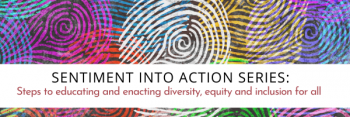
Sentiment Into Action #1: Steps to Address Levels of Racism
By Dr. Florence HollandPublished June 15, 2020Perspective, experience and actions brought to you by Dr. Florence Holland, Diversity, Inclusion and Education expert, speaker, advisor and all around awesome individual.
Friday, June 5, 2020, should have been a day where my feelings were steeped in just the thoughts of how my 15 and ½ year old is growing up and that my insurance was about to skyrocket. Instead, I was more worried about having to have "the talk” that many other African American parents of boys have told me about. That yes, obtaining his driver’s permit was not only a responsibility, but a potential death sentence if he does not respond accordingly when pulled over by law enforcement. It was a day of smiles and happiness, but also a day where I felt deep sadness because I could no longer protect him or his bubble of innocence any longer.
So as an African American parent, employee, community member and church parishioner, I am no longer impressed by the many firms, organizations and associations expressing sentiments of deep sadness by recent events and/or denouncing racism and discrimination. I am ready to go beyond sentiments into an expectation for ACTION. So, how can you take statements beyond words?
Associations should and must use their privilege to address areas of racism at all levels. Associations have to truly take those statements, bring them to life and finds ways to make them long lasting – internally, interpersonally, institutionally and systemically.
The goal is true inclusion for all members of our organizations, but more importantly our society, to feel a sense of belonging. This can only happen and withstand if our approaches are strategic and with personal touches that cover all levels of racism discussed below.
Internalized Racism is race-based beliefs and feelings within individuals. Associations should look at their membership and understand the ways internalized racism could be affecting their members personally.
Programming and initiatives to combat this could include:
- Conduct research on the internalized racism of underrepresented minorities in the industry or supported profession.
- Provide educational opportunities for underrepresented minorities related to stereotype threats.
- Create marketing materials and support others that are fostering a sense of belonging in your industry or profession. Materials should provide narratives of students and professionals who have struggled but have now reached “achievement” within your field.
- Expose students to successful role models who refute negative stereotypes.
- Provide access to on-demand career coaches and assistance for first generation and/or underrepresented minorities to build growth mindsets, reflection on decisions, how to navigate the industry/profession and how to help students manage feelings of stress and threats.
Interpersonal Racism comprises of bigotry and biases shown between individuals through word and action. Here is where associations can influence the interactions between members.
Suggestions to combat interpersonal racism could include:
- Conduct unconscious bias or belonging training for all association staff and members.
- Create a train the trainer model of training for association members to use in their various spheres of influence.
- Sponsor/host learning opportunities, sessions, and speakers with educational sessions on diversity, inclusion and belonging.
- Support programming where deliberate intercultural individuals are placed in work groups and committees to achieve a common goal or purpose.
Institutional Racism extends to discriminatory policies and practices within organizations and institutions. Associations must do the work here, internally, to truly address how their work, policies or procedures impact its staff, volunteers or members.
Efforts to aid in addressing institutional racism include:
- Review all association documents (program requirements, membership applications, ways to obtain information, etc.) to ensure there are not biases built into the process or documents required.
- Review measurements used to award funds, grant membership or track effectiveness of programming. Again, check for unconscious biases that may have been deemed acceptable, but are not necessary and cause individuals to be unfairly grouped.
- Evaluate all association partnership and sponsors, verifying their statements and positions on racism, diversity and inclusion align with those of your organization.
- Create avenues for earmarked funding donations related to diversity programming and scholarships.
Systemic Racism is the ongoing racial inequalities maintained by society. Organizations should look at their fields/professions/trades to see if there are known ways the work they do adds to systemic racism practices.
Some ways associations can combat systemic racism include:
- Provide grants for Minority-Serving Institutions (specifically HBCUs and HSIs) to help upgrade technology and facility infrastructures to combat disparity and close the digital divide.
- Provide funds for endowed professorships at Minority-Serving Institutions so the school may have the opportunity to raise/supplement faculty salaries.
- Support the education of the field's or profession's minority faculty to ensure they stay relevant in the field.
Provide free memberships to minority students who are interested in the field/profession to ensure access regardless of their economic status. - Create programs and grants to support graduate students such as travel grants, data centers for research, formal mentoring relationships between experts/scholars and minority graduate students, master’s level conference/cohort building and assistant/internships.
- Launch program for minority-owned businesses and suppliers related to the field/industry you are in.
